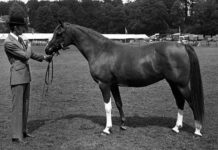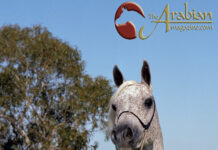With WAHO Abu Dhabi ending last weekend, we thought we would share this treasure from our archives – Barry Shepherd’s look back at The Royal Stables of the late HH Sheikh Zayed bin Sultan al Nahyan. We first ran this in The Arabian Magazine in 2009 and again in The Arabian Breeders’ Magazine in 2022. Please enjoy part one of our look back at this most iconic stables.
In response to a groom’s whistle, just as the setting sun begins to illuminate the Arabian night, a cloud of dust appears on the desert horizon and suddenly at the gallop, a herd of horses appears – a spectacular sight. This was my first recollection of the Royal Stables of Abu Dhabi. The setting was Ash’aab, some 30km from the capital, at a site personally chosen by the late Sheikh Zayed Bin Sultan Al Nahyan for the expansion of his famed Royal Stables in 1981. Here, youngstock are sent to grow in freedom, older horses retire, and all broodmares spend the hot summers under shady shelters in the heart of the Arabian homeland.
The chief private stud is to be found on the edge of a bustling Mecca, that of Abu Dhabi. This glittering island city is the capital of the United Arab Emirates and was formed in 1971 when the British influence was withdrawn from the Trucial States and the seven sheikhdoms, of which Abu Dhabi is the largest, amalgamated. Here the Royal Stables of the Late HH Sheikh Zayed Bin Sultan Al Nahyan, then supreme Ruler, Founder and President of the UAE, was first established in 1969 under the Directorship of Colonel EB Wilson, a much-respected military man who was honoured with this position by Sheikh Zayed as a thank you for helping to overthrow his brother, the previous ruler. HH Sheikh Zayed then went on to fulfil his vision to lead the nation to become one of the greatest countries in the world today, truly an amazing accomplishment for a bedu man born and bred in the Arabian desert. One of his most cherished dreams was to re-establish the Arabian horse into its original desert setting. At the very beginning of the stud’s life, there was an equine population that numbered around 30 horses, many of mixed or unknown breeding. The first imports to realise his dream came from England, where so many studs have sourced their foundation stock from the Crabbet lines. Sheikh Zayed became a great fan of the British Arabian horse and paid them high praise for their quality, substance and athletic ability describing them as the ‘classic’ Arabian. Horses from Russia, America, Australia, and Europe were to follow and then the Royal Stables were ready to breed the next generation.
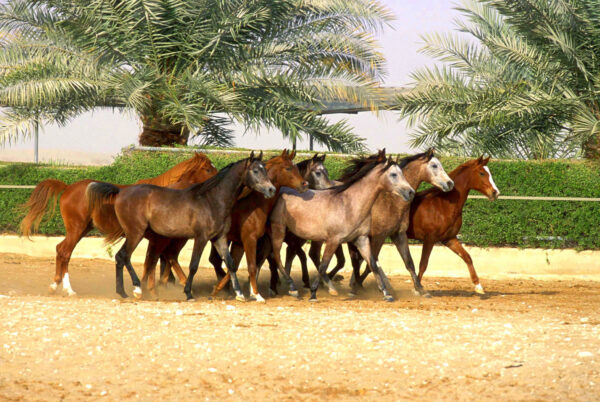
Joining WAHO
In 1986, delegates from the Middle East attended the WAHO conference in Morocco; as a result, moves were made to form a UAE Arabian Horse Stud Book. In 1992 under the chair of one of HH Sheikh Zayed’s sons, HE Sheikh Hazza Bin Zayed, and Dr Abu Bakre, appointed as full time registrar, a state of the art office building was set up in Abu Dhabi. These offices boasted the latest computer technology with links to the World Arabian Horse DataSource, for which it was the original guinea pig. Many of the horses at that time came from original desert stock and belonged to societies not yet recognised by WAHO. Each had to be checked and rechecked for authentic sources and eventually 58 horses were classed as original Arabian horses.
Five years later saw the initial application of the UAE to join WAHO at the London conference. The first studbook was published and accepted two years later with 21 owners and 313 horses; of these 213 belonged to Sheikh Zayed’s various stables. Volume two was published in 1994 with an explosion in numbers; there were now 63 owners and 357 new horses. Racing had also started to be recognised by the ruling families of the Gulf and it flourished with vigour. The UAE was the first registry to insist to passport every horse. In just 10 short years after the stirrings of interest in recording the pure-bred population, Abu Dhabi played host to their first WAHO conference. It is typical of this part of the world that when it sets out to achieve something, no short measures are taken, and it rapidly moves to the forefront of whatever goals it sets.
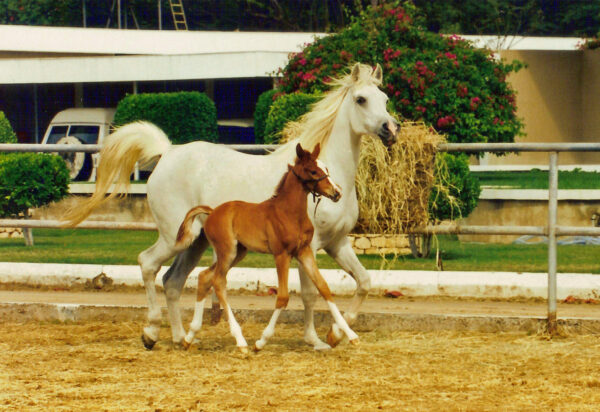
The beginnings
A deep love for and understanding of Arabian horses kept His Highness Sheikh Zayed personally involved with the Royal Stables over the years, selecting horses for purchase and choosing breeding stallions to be used. His quiet influence could also be felt worldwide by the many events he sponsored that promoted the well-being and future of the pure-bred Arabian horse. Sheikh Zayed was the Patron of the Arab Horse Society of Great Britain until the end of his life; he orchestrated world-class endurance races in Australia and hosted a fleet of the finest Arabian race meetings. Abu Dhabi has dedicated itself to the celebration of the Arabian horse. His philosophy was to breed beautiful, athletic horses that possessed the grace and stamina and enabled them to carve their own future from the harsh desert wilderness at the beginnings of time. He wanted a stallion to look like a warrior, full of fire, power and energy, and the mares to be serene, regal and proud; this was the Bedouin way. The stud in its heyday stood more than 400 horses with every year bringing new foals for three different spheres: racing, showing and later endurance. If a horse could succeed in all three in its lifetime, then Sheikh Zayed’s dreams had turned into reality.
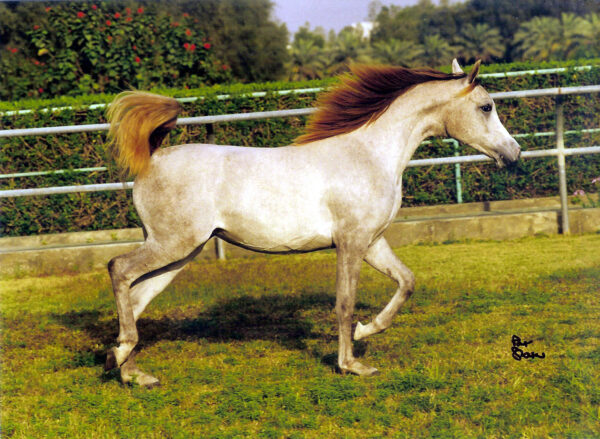
The Royal Stables stood in true royal grandeur. Emerald green lawns, flanked by palm tree-lined avenues and a vast array of colour from the vibrant bougainvillea. In beautifully manicured paddocks, horses grazed in peace and harmony. A luxury racehorse training facility complete with a grass and dirt track was installed adjacent to the Royal Stables and the older horses were sent there to be backed to ride and, in turn, race, before retiring back to the breeding stables if they had achieved a satisfactory declaration to breed on another generation. A team of the very best from around the globe helped keep this stud at the very fore of Arabian horse breeding. The stallions were available free of charge to local mare owners as the Stud, like many of things that was owned by Sheikh Zayed, was not only for him, but more importantly, for his people. It was his wish to encourage their interest in their heritage of the Arabian horse and to help them improve their own stock.
Shows
It must be noted that in those early years, there were no horse shows in the UAE until 1996, so the horses were sent overseas by plane to compete. 1988 saw the first show in Jordan, the prestigious Middle East Championships. Further visits to Jordan and Iraq followed in 1990. The Gulf War then halted proceedings until 1994 when Qatar held their first international show.
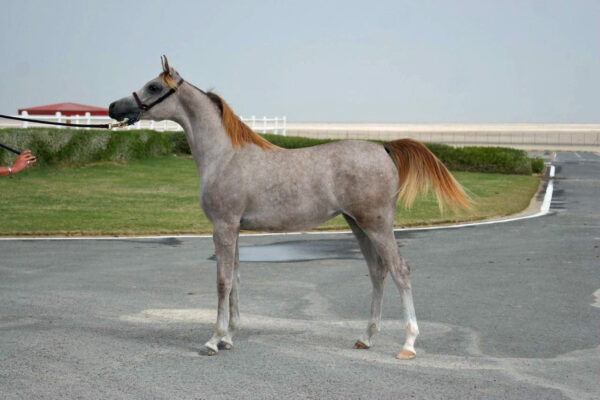
Setting the foundations
Dam lines are vitally important in any stud, and it was with great care that these were first chosen. These original mares have gone on to create their own dynasties within the stud and in turn, across the gulf. The first two mares to arrive to upgrade the existing horses came from Michael Pitt-Rivers’ Courthouse Stud in England in 1981. These were Daza (Nasib x Dahshan) and Nadea (Zehros x Indian Snowflake). These mares went onto produce well, but it was Nadea’s only daughter from two foals before her untimely death in 1985, Kuhaylah Saffra sired by Nasib (Indriss x Nimet), who had the greatest effect on the stud. She held a key position becoming the dam, granddam, great granddam and now a great-great-granddam of some of the best show horses that the Middle East has to offer. Her 1986 daughter Kuhaylah al Shagra by Sambhur (Rafid x Osprey) went onto produce the 1992 mare Khazna by Vain Hussar (Ragos x Mirella), who produced the 1998 Jordanian Champion Filly Kubaisha by Maleik el Kheil (El Shaklan x Muneera). Her daughter, the 2006 mare Al Aryam Karubi (by Sanadik el Shaklan) started another successful generation. Another daughter of note for Kuhaylah Saffra was the breath-taking 1992 Aboud (Diamond Star x Azeme Bint Gleam) daughter, Kaida. This classically beautiful mare was one of HH Sheikh Zayed’s personal favourites; she was the epitome of all his beliefs. Her 2002 daughter, RS Kasiba (by Da Vinci KA) was to become one of the biggest success stories for the stud.
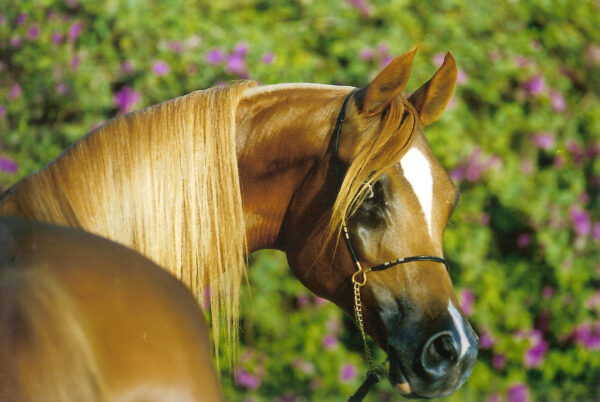
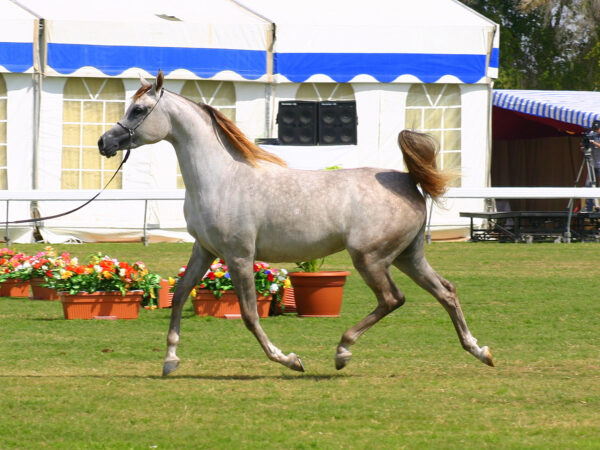
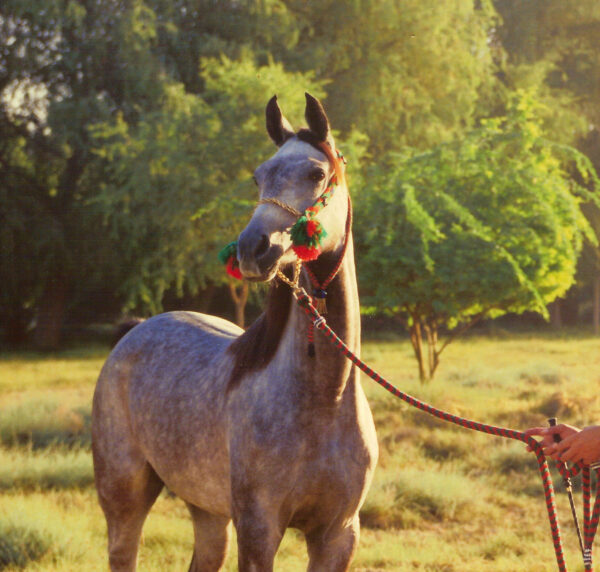
Other mares to follow at the beginning were Aeisha (Kurashi x Princess Moonshine) in 1987 and she featured heavily in the breeding programme. Bred by Miss Demulder in the UK, she was bought by the Ruler of Sharjah as a gift for HH Sheikh Zayed. Her dam line goes back to a mare imported into England back in 1939, Takritiyah, who was bred by Haji Daham Haji Daud, Sheikh of the Abu Nissar tribe and founded a small and little known family. Aeisha inherited the very best from her parents and had a truly regal look about her. Her first daughter by Aboud, the charismatic Aseela, won many titles as a junior in the show-ring. Like all the Aboud daughters, and the mark of any great mare, Aseela has produced some excellent foals. Her first daughter, the 1998 mare RS Asfoora (by Dunaj), won twice as a yearling and carried on her winning ways for the rest of her junior career. She was also placed second twice on the racetrack and would go on to produce halter champions herself. Aseela’s two full sister daughters, 1997 Attalah and 2007 Al Aryam Aurora, both by Maleik el Kheil, took the show-rings by storm in their early years winning in Qatar and Jordan as well as the Emirates. Another big winner was her 2000 born son, RS Adel by Centre Highwayman (Desperado x Centre Mantilla).
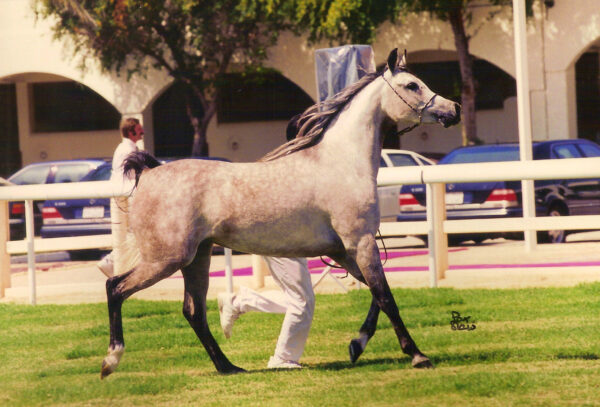

Again, the UK laid down two more vitally important families. Maarena was a grey mare gifted to HH Sheikh Zayed from the Ruler of Oman in 1987. Bred by Kerry Wilson, Maarena was sired by White Larzan (Nasral x Perindian) and out of September Shade (Bey Shadow x September Gold). An interesting note is that the Russian mare September Gold was the first Arabian horse that I ever showed at the tender age of seven. Maarena’s most successful daughter was Mamluka, sired by the Russian Oaks winner Secundant (Aromat x Secunda). This mare has foaled many beautiful and versatile horses that have won in the show-ring, on the racetrack, and in endurance.
The gorgeous 1986 mare Ghaflah arrived at the Royal Stables breeding barn 1989. This feminine little chestnut mare was a mix of Russian/Polish and old Egyptian/English bloodlines. Bred by Mary Bancroft, Ghaflah was sired by the American-bred Muscabar (Muscat x Karhonova) and from Nataliah (Nazim x Nasra), a maternal half-sister to the top racehorse Balaton’s Gem (by Balaton) who was still racing at the ripe old age of 16. Although she produced mainly colts, when Ghaflah was bred to the great Aboud, she produced the ever-beautiful Gariah. This outstanding mare was a clear reminder of her illustrious parentage. She went on to produce some outstanding foals and although never shown as she had a blue eye, she was practically perfect in every other way.

Looking to further improve the mare band, Russia held the next piece of the breeding jigsaw. They brought in compact, strong bodies, and good limbs, and crowned it off with that powerful driving trot that is their trademark. The 1987 grey mare FA Protea (Prononce x Pechenga) arrived to the desert as a weanling and soon rose to stardom when she was titled Qatar International Female Champion. Russian bred, although she lacks the trademark link with Aswan (Nazeer x Yosreia), Protea proved to be a very versatile breeder producing show winners such as RS Farasha (by Centre Highwayman) as well as being dam to multiple race winner RS Fayeq, a 1996 colt by French racing sire Ne Rien Prendre (Djelfor x Ne Rein Faire).
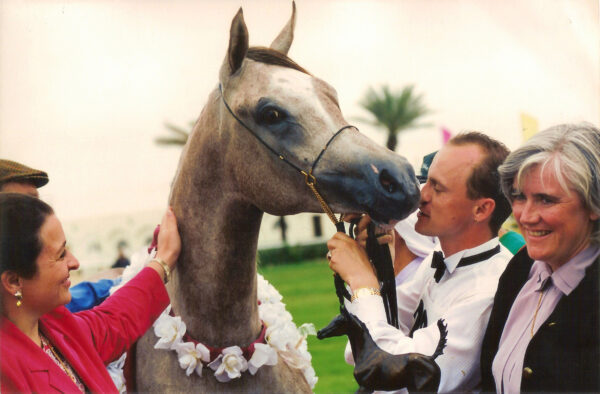
Another very important acquisition also to come from Russia arrived in1992; this was the chestnut splendour, Verdjinia (Nimroz x Vengria). This queen of the stable went on to create her own legacy. Her first foal, the glorious Batala (by Aspirant) was imported in utero and was crowned 1995 Qatar International Champion Filly. Batala went on to be successful on the racetrack before retiring and becoming the cornerstone of the breeding barn. Batala, meaning heroine, produced many star foals including RS Banafsaj (by Maleik el Kheil), her full brother RS Batal el Kheil, RS Boushra (by Padrons Psyche) and her last foal before her tragic death leaving an orphan daughter, the breath-taking Al Aryam Balkeas (by Gazal al Shaqab).
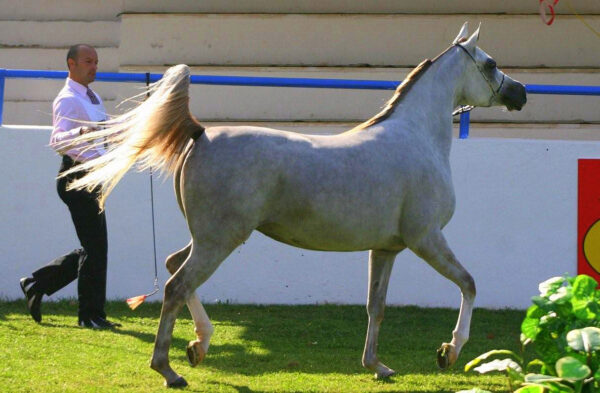
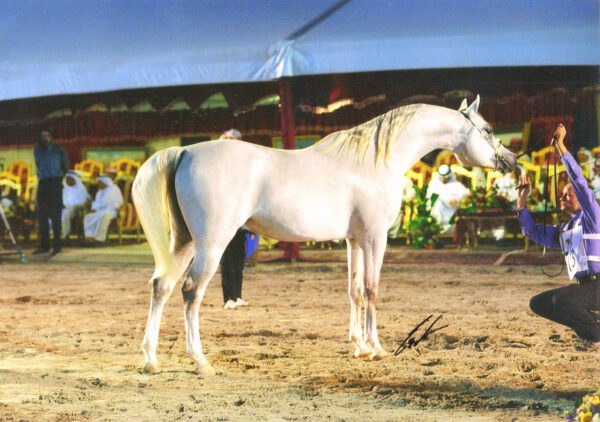
Another offspring of Verdjinia, this time by Pakistan (Kumir x Panagia), thus making a three-quarter brother to Batala, is the outstanding stallion Burkan. Declared by then stud manager Deirdre Hyde on the birth of Burkan, she recalls: “Rarely does one see a foal that is special from the start; you know he will go on to do great things.” Never a truer word has been spoken. This mind-blowing beautiful alabaster stallion looked like a sculpture come to life. His enviable credentials include being named Middle East Champion, UAE National Champion, Ajman Champion, Sharjah Champion, and Abu Dhabi Champion as well as siring international winners and UAE National Champions. He certainly was the jewel in the Royal Stable’s imperial crown.
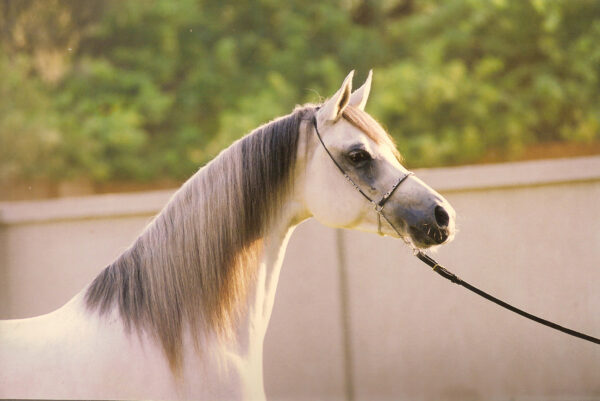
Another mare of merit is the exotic 2004 UAE National Champion Mare, Krishayl. Born in 1989, this snow-white beauty was by Ralvon Job (Milex x Ralvon Silver Jubilee) and out of Ralvon Sierra (Ralvon Pilgrim x Ralvon Ritana)). Krishayl was shown successfully in her homeland of Australia before arriving in Abu Dhabi in 1992. She won in the show-ring both under saddle and at halter and in between, producing the first UAE National Champion Filly, Karama (by Aboud) in 1995.
Part two of this feature, which focuses on the stallions and the end of The Royal Stables, will be published next Thursday.


